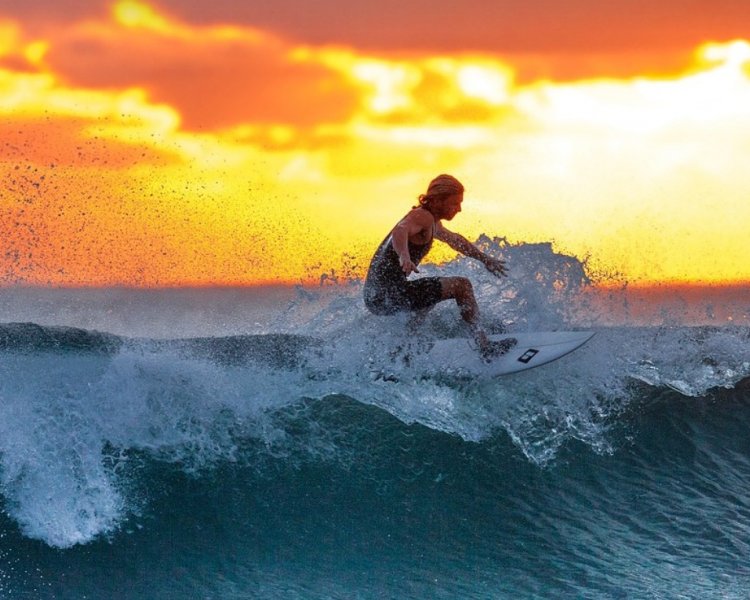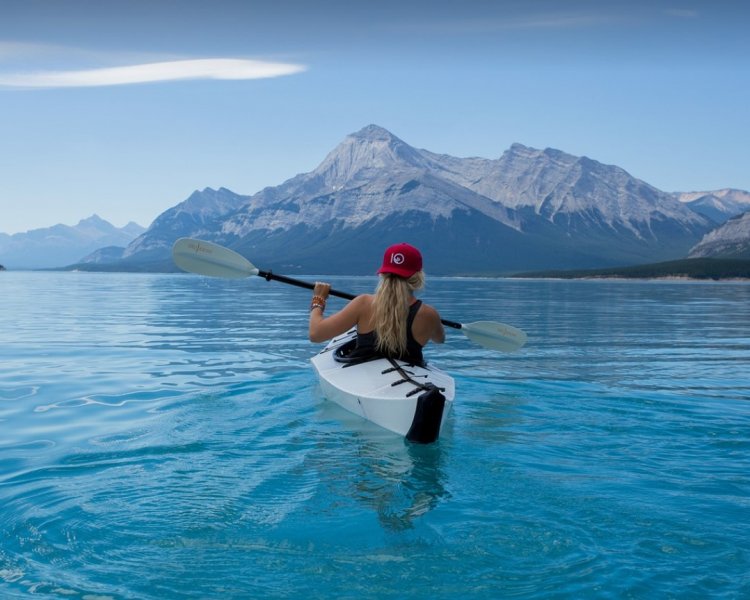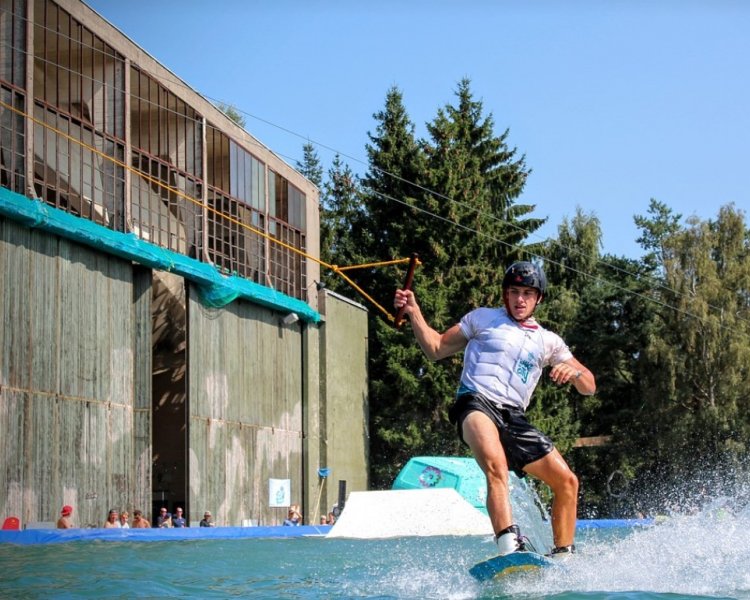Paddleboards Vs. Surfboards? (5 Key Differences)

Surfing and paddleboarding are two very popular water sports. However, the boards are very different in how they are made and the material they are made out of. It is important to understand these differences when comparing a paddleboard and a surfboard.
What is the difference between paddleboards and surfboards? Paddleboards and surfboards differ in how they are made, leading to differences in flotation, dimensions, decking, rocker, and types.
Paddleboarding and surfing have two different goals.
They are both meant to float, so both boards are built based on a similar concept: a foam core wrapped in a protective outer layer, often fiberglass or epoxy. However, because the two boards have different functions, they vary in how that basic design is implemented.
| Paddleboard | Surfboard – Short | Surfboard – Long | |
| Flotation | 100 liters foam volume | 25 -32 liters foam | 85 liters foam |
| Dimensions | Length: 10-11 feet Width: 32-34 inches Thickness: 4 inches |
Length: 7-8 feet
Width: 20-22 inches Thickness: 2.5-3 inches |
Length: 8-14 feet
Width: 22-24 inches Thickness: 2.5- 3 inches |
| Decking | Reinforced, often with padding | Thinner grip provided through waxing | Thinner grip provided through waxing |
| Rocker | Mostly flat | Variety of shapes, but typically more curve | More curve |
| Types | Several different types based on the purpose | One type | One type |
| Pricing | $500-3000 | $150-300 | $250-500 |
Example Of Paddleboard
Roc Inflatable Stand Up Paddle Boards W Free Premium SUP Accessories & Backpack
Great inflatable paddleboard to get started. Easy to set up, lightweight and durable.


Example Of Surfboard
Soft Top Surfboard
Solid option for beginners. Stable, and easy to stand up. It comes in different colors.


5 Facts: Difference Between The Boards!
Fact 1: Paddleboards have more flotation.
Paddleboards are designed to hold the full weight of a person as they are standing on the board without sinking. This means they must have enough flotation built into them to prevent them from sinking under the rider. The higher the foam core, the more flotation a board will have.
Paddleboards typically have 100 liters of foam volume in their core.
Surfboards do not need to have as much buoyancy.
The rider typically sits or lays on the board distributing weight over a wider range. If the board sinks slightly in the water during these times, it does not make it more difficult to control, unlike a paddleboard sinking.
When the rider stands, the movement of the waves and the speed of the board increases the buoyancy and keeps it from sinking.
Surfboards vary in that their foam volume based on size.
As typical (shortboard) surfboard will have 23-24 liters of foam volume. A longboard will be closer to a paddleboard, with 85 liters. However, even a longboard will be prone to some sinking if stood on for longer periods of time or on flat water making balance and maneuverability difficult for all but the most expert riders.
Fact 2: Paddleboards and Surfboards are built to different dimensions.
Paddleboards are usually wider and thicker than surfboards of the same length.
This is caused in part by the larger foam volume and is built into the board to create more stability.
Paddleboards often start at 4 inches thick, whereas surfboards can be as thin as two inches depending on the size and weight of rider they are designed for.
Surfboards range from 5 feet to over 10 feet long. They are designed to be thinner so that you can straddle them with your legs while sitting.
Even longboards are usually 23.5 inches wide or less. Paddleboards are typically over feet long and very wide. The differences in their shapes are part of what creates the differences in their maneuverability.
Surfboards are waxed to create a grip that allows the rider to stand and help with balance.
Paddleboards often have either a textured surface or a gripping surface on top of the board to help prevent sliding.
Fact 3: Paddleboards have stronger decking.
Paddleboards must have decking that will stand up to all the rider's weight being concentrated in two spots the size of their feet.
Without reinforcement, the decking of a paddleboard would slowly sink and break from the weight of the rider. The reinforced decking of a paddleboard adds to the weight of the board and the thickness. It will decrease the maneuverability and speed of the board.
Paddleboard decking may be further reinforced with a special material to make paddling from the kneeling position more comfortable.
Other paddleboards have reinforcement or padding in the decking to accommodate the rider fishing or doing yoga on the paddleboard. The most lightweight paddleboards will have some sinking before the decking stabilizes because of reduced reinforcement.
Surfboards are made to be lightweight, fast, and maneuverable.
They do not need reinforced decking as the rider is not standing the whole time. When the rider is lying down or sitting their weight is more evenly distributed throughout the board negating the need reinforcement.
Surfboards are covered in a layer of fiberglass, creating a harder top.
Fact 4: The boards have different shaped rockers.
The rocker is the curve in a board (surfing or paddling) from the nose to tail that gives it a faint banana shape.
Boards have more or less curve depending on what they are designed for. The purpose of this curve is to help the board fit the curvature of the wave.
The more rocker, the bigger the wave the board can “fit.”
Both surfboards and paddleboards are constructed with rocker.
Surfboards have more rocker allowing them to drive into the wave. This allows the board to cling to the wave as the surfer maneuvers over the wave surface. The rocker will help the surfer respond faster and change directions quickly. Advanced riders will need more rocker for steeper waves and to surf in the curl of the wave.
Paddleboards have a long flat rocker that is better for gliding and tracking.
This can increase the efficiency of the glide so that less effort is needed for paddling. It also means that the paddleboards do better on flat water, such as a bay, lake, or open ocean.
Paddleboards are going to require less skill and energy to keep them going straight. Some paddleboards do have more rocker for use in waves.
Fact 5: Paddleboards come in a wider variety of types.
Surfboards are made for surfing.
The board may vary in size and shape due to the weight and experience of the rider and/or the shape and size of the waves.
The basic use of a paddleboard is to paddle through the water. However, they are put to many other uses, resulting in board variations to accommodate these uses.
Different material is also used at times to help with these variations.
Many paddleboards are multipurpose and can be used for more than one activity.
However, it is important to know what specific boards are designed to do before a rider uses/buys one. Each different design type has its own pros and cons. The size, shape, and stability of the board vary depending on the purpose.
All-around and touring paddleboards are often designed with more stability and are easier for beginners.
Surfing and high-performance paddleboards are for intermediate to advance paddlers that want more waves or speed in their experience. Some boards are also designed so that people can fish or do yoga on them.
There are even inflatable paddleboards that can be deflated for storage.
Pricing: Paddleboards vs. Surfboards
Surfboards vary in price based on if they are a short- or longboard. Custom made surfboards made for advanced riders, and extreme waves can become very expensive. However, the typical, “off the rack” surfboard is usually between $150-$300. They are almost always under $1,000.
Paddleboards typically cost more.
They often start at $500 for boards that can be purchased at a sporting goods store and cost upwards of $3,000 custom boards at specialty shops. The added cost is due to the extra material and the customization for specific uses. Paddleboards often also take extra designing to ensure buoyancy, and this cost is passed on to the customer.
Clothing: Paddleboards vs. Surfboards
Waterproof or water-resistant clothing is recommended for paddleboarding.
We made an extensive article about wetsuits for paddleboarding. You can take a look by clicking here.
Bringing a dry bag with you is essential for long days on the water. As you shed layers, you can put them in the dry bag so that you have something warmer and dry to wear.
Bathing suits for a bottom layer allows you to jump in and swim if you want.
Paddleboarding is best done barefoot so you can feel the board with your feet.
It is important to remember that paddleboards are recognized as a vessel by the Coast Guard.
This means you will have to wear or have with you a USCG-approved life jacket at all times.
Children under 12 are required to wear a USCG-approved life jacket at all times.
Smaller compact life jackets that buckle around your waist is one option that complies with this rule and allows freedom of movement.
For surfing, you do not need a life jacket as they are not recognized as vessels.
What you wear will depend on the water temperature. Since you stay in the water more, water temperature is more important than air temperature when choosing attire.
Wet suits are considered “typical,” but are really only needed for colder water. In warmer water, board shorts and a rash guard shirt are more common.
One thing needed by both paddleboarders and surfers is a leash so that you do not lose your board. Without it, a person can get separated from their board and struggle to swim back to it through the waves.
Dual-Purpose Use? Is it Possible?
Due to the expense, many riders will not want to own two boards, a surfboard, and a paddleboard.
One option is a surfing style paddleboard. It is built to be lighter and smaller than surfboard so that it can respond to the waves and the rider faster and better. But it will not respond as well as a surfboard, and certain surfing maneuvers will be close to impossible.
If you want to know more details about using one table for both sports, check out this post.
Can a surfboard be used as a paddleboard?
The shortest answer is no. The surfboard does not have enough flotation and stability to have a person standing on it. The board would sink and become very difficult to balance. A smaller or very experienced rider may be able to make it work in the short term. In the longer term, it is likely to be uncomfortable and damage the board.
Can a paddleboard be used as a surfboard?
Again, the answer is not well. Some paddleboards are made to be “surfing style” boards. However, most boards are too slow to turn and will not respond to the rider fast enough to move with the wave. They just do not have the maneuverability that a surfboard does.
Surfing vs. Paddleboarding: Interesting Facts
Surfing has been around for over 240 years! Paddleboarding is in its infancy in comparison. Here are some fun facts about this history of surfing.
- Captain James Cook was the first to document seeing surfing being practiced in 1778 in Hawaii.
- The first surfing contest took place in 1928 at Corona del Mar, California.
- Plymouth University in the UK has had a Surf Science and Technology degree since 1999.
- The longest surf ride was 3 hours and 55 minutes. Gary Saavedra set the record in 2011 riding an artificial wave.
- The biggest wave ever recorded was 1738 feet tall. That is 500 feet taller than the Empire State Building.
- The record for most people on one surfboard is 47. This was done in Snappers Rocks Australia. Yes, they actually “surfed while all on the board.
Paddleboarding has become one of the fastest-growing sports in the United States.
They are now over 150,000 paddleboarders in the United States. Paddleboards are now considered “vessels” by the Coast Guard similar to kayaks and canoes.
Paddleboarding originated in Hawaii and was brought to California in 2004 by Rick Thomas.
John Zapotocky is considered the father of modern-day paddleboarding.
Paddleboarding and surfing both have their roots in ancient Peruvian fishermen who used a cross between a paddleboard and a surfboard for fishing.
Today, the two sports have diverged creating specialized boards that are used for a variety of on the water activities. The boards do remain somewhat similar in shape and design but are very different in their final products.
...
Læs: avxperten- har ydet økonomisk støtte til denne tekst. Der kan du, udover mange andre ting, shoppe havebelysning. Derfor er denne tekst markeret.



